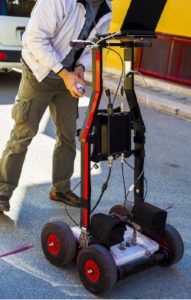
Ground-penetrating radar is a method of underground utility locating that helps to identify items that are beneath the surface of a construction site. These underground utilities could include traffic lights, telephone lines, natural gas, and electric grids, among other things. Companies use various detection methods for finding everything buried underground. That said, ground-penetrating radar is widely considered to be one of the safest ways people can find underground lines.
Understanding Ground Penetrating Radar
Ground-penetrating radar (GPR), as mentioned previously, is used to detect utilities that are beneath the surface. It does this by emitting radar pulses. These radar pulses travel through the ground, then bounce back up to the surface. While underground, obstructions that are underground will influence these radar pulses, indicating that something is buried there. It even allows workers to create 3D images of underground water, pipe, sewage, and power lines.
It’s a type of technology that has gotten more popular in the United States and is even seeing more usage in Europe as well. It’s also great because ground-penetrating radar doesn’t have as much risk attached to it. It even saves people a lot of time and resources.
Benefits of Ground Penetrating Radar
- GPR is non-destructive. It doesn’t require any digging to detect anything. It simply uses electromagnetic pulses to find everything in the subsurface. This makes GPR a non-intrusive utility locating option.
- You can get highly accurate results using GPR. You can find anything from plastic pipes to pipe leakage to metallic drums. It also detects the exact spot where the utility is.
- On top of being safe and highly accurate, GPR is a more cost-effective solution for utility locating. GPR causes minimal damage, meaning you don’t have to spend as much on repairs. You also lower the risk of worker injuries and setbacks, which helps to save you time and money.
- Another benefit of GPR is that it is more user-friendly. Other utility locating methods require highly-skilled people to operate them. GPR doesn’t demand as much training to operate effectively. It’s easy to understand even with only a small amount of training needed.
Concrete Visions Will Get The Job Done Right
Concrete Visions has been working with clients for over 25 years. Our G&M Services installers are certified with the industry’s major firestop product manufacturers. As part of our firestop service, we can assess abnormal field conditions and, with the manufacturer’s technical support assistance, provide engineering judgments in a timely fashion to comply with contract specifications. Our Field Mechanics undergo ongoing training, including mandatory monthly safety meetings, weekly Toolbox Talks where safety and equipment information is shred, and trainings on safe work standards and safety best practices.
